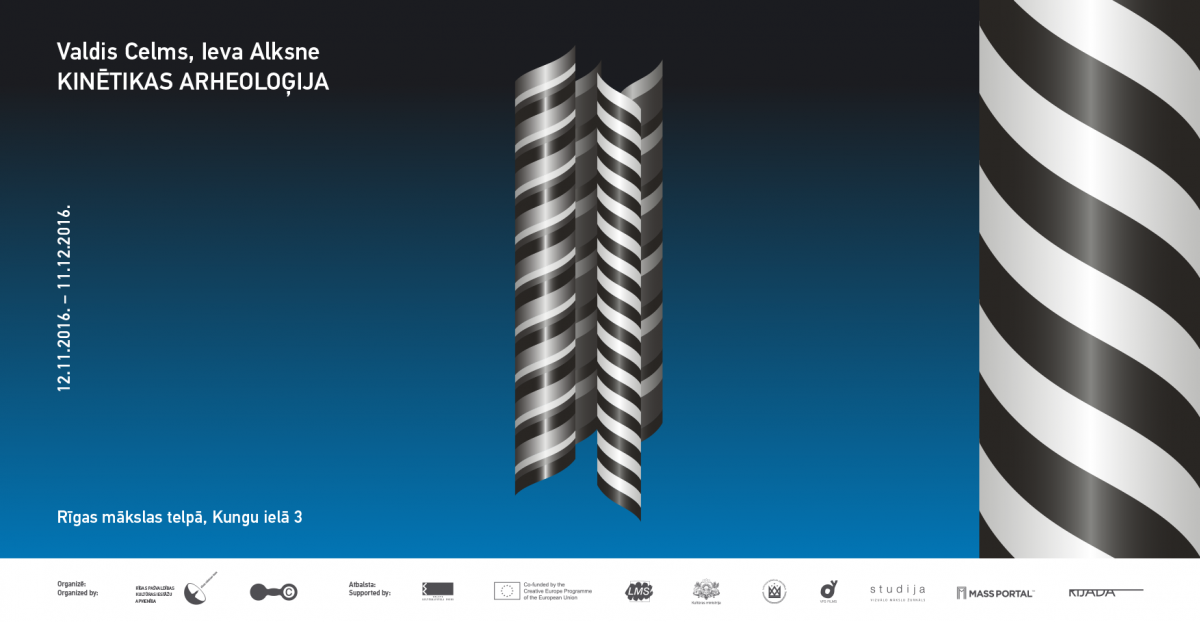
At 4pm on Saturday 12 November 2016 at the Riga Art Space, the exhibition Archaeology of Kinetics by artist Valdis Celms and restorer Ieva Alksne will be launched in cooperation with the Latvian Centre for Contemporary Art. The exposition is created as an open laboratory revealing the making of kinetic art in Latvia in the 1960s and 1970s and accentuating its conservation issues nowadays.
The exposition is created as an open laboratory revealing the making of kinetic art in Latvia in the 1960s and 1970s and accentuating its conservation issues nowadays. The spatial scenography as a creative dialogue between both authors has been made by designer Rihards Funts (“Rijada”). The curator of the exhibition is art historian Ieva Astahovska.
Valdis Celms is one of the most outstanding representatives of kinetic art in Latvia. His oeuvre is amazing evidence to the fact that in the soviet period, too, avant-garde and visionary artwork was made in Latvia. These works of art were as convincing as their counterparts in the West and elsewhere in the world in the 1960s and 1970s. Unfortunately, kinetic artwork nowadays is often found at a critical state. The untraditional, complicated and at that time innovative solutions, which ensured the essence of the kinetic art in terms of mechanical or other type of movement, often is out of order, thus restricting the opportunities to appreciate the avant-garde means of expression. These conservation issues also delay the inclusion of the artwork in the collections of museums.
Two important works by Valdis Celms – Greece and the Fourth Stage – were restored by Ieva Alksne in 2015. The artist made the object Greece in parallel to his academic assignments, while being a student at the Art Academy. The work was created as the author’s commentary to the situation in Greece, where in 1967 coup d’état took place. The decorative expression of the work of art attests to the artist’s quests in the direction of Pop Art. Whereas the kinetic object of art The Fourth Stage was exhibited for the first time at the 1978 exhibition Form. Colour. Dynamics. at St. Peter’s Church. It was made as a variation of the earlier artist’s project Positron, intended as a large-scale kinetic sculpture at the electronics factory in Ukraine to create a relaxing atmosphere for the factory workers. The project was not implemented, however its model is currently located at the museum collection of the Rutgers University, the USA. Positron and the related work The Fourth Stage became the field of research and experiments, where Valdis Celms could examine the practical and theoretical possibilities of kinetics.
The restoration of works Greece and The Fourth Stage was possible due to the fact that the work components, materials and information about them were carefully stored at the artist’s archive. Using photographs, drawings and video, the exposition is arranged in a way that the visitors could have an insight in the restoration process, become acquainted with the materials and technologies, as well as become aware of the dilemmas and methods of the restoration process. It can be question how and whether it is necessary to preserve the materials, which age with time and are not being produced anymore, not to mention the fact that the number of craftsmen, who could repair the technologies of that time, also decreases. It is a challenge to decide which qualities of the artwork should be conserved, when the compromise is impossible – is it worth to restore the movement using modern materials or to preserve the initial technological solution, even if the light, sound and movement is lost?
Especially for the exhibition, a short film about Valdis Celms’ kinetic works of art is made in cooperation with the VFS Films. It was shot at Valdis Celms’ studio in the vicinity of Amatciems, where the disassembled works, their fragments, components and materials can still be found in the attic. This unique environment both literally and metaphorically embodies the central axis of the exhibition – the seemingly forgotten works of art made in the soviet period, especially the kinetic works of art, which at the same time have the potential to be restored retrieving the previous physical form.
In the framework of the exhibition, creative workshops for families with pre-school and school children will be organised. Also, the visitors will have an opportunity to meet the authors of the exhibition. The exhibition is organised by the Latvian Centre for Contemporary Art (LCCA). The LCCA is engaged not only in the curating activities, but also in archival issues of contemporary art, material conservation and artwork restoration.
The exhibition will be open till 11 December 2016 at the Riga Art Space on 3 Kungu Street.
The entrance fee: 5.00 EUR; school children and students (presenting a student card): 2.50 EUR; pensioners (presenting a pensioner concession card): 3.00 EUR. Entrance fee to the events organised in the framework of the exhibition – half of the price for all groups of tickets.
Video: